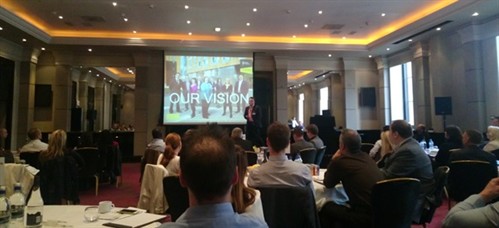
Last week, the fantastic marketing event, On the Edge, took place in the Radisson Blu Hotel in Manchester. Attended by marketers, business owners and PRs alike, the event offered insight from key experts in the marketing industry about how digital is shaping the sector and helping it evolve. And here at The Candidate we were delighted to be the headline sponsor!
Guest speakers included Nick Bamber, head of digital media and innovation at ASDA, John Bower, digital innovation specialist at Hallmark Cards, Stefan Casey, business innovation manager at The Retail Institute, and Louise Fowler, marketing director at First Direct.
The interactive event followed a slightly different format to the normal structure of a conference, and after each speaker slot attendees were asked to get involved in round-table sessions. The round-tables discussed a question relevant to the topics covered by that particular speaker and after each session, attendees were asked to move to a different table in order to mix with other professionals in the sector and discuss their thoughts. This enhanced opportunities for networking and meant there was a real conversation between marketers concerning the key themes emerging throughout the afternoon.
In case you missed the event, here are a number of key takeaways we wanted to share with you:
Linking online marketing to in-store success:
Nick from ASDA pointed out the strengths and weaknesses of digital marketing and using it to engage with consumers and promote your brand.
In particular, he discussed the difficulty of measuring the results of social media, especially for bricks and mortar stores. If you put two completely different posts on your Facebook wall and they both get a great response, for example, there is no way to tell which might have contributed to a boost of customers going into a store.
For an online business, you can measure traffic to the website and see when it corresponds with specific social media posts, but with bricks and mortar stores it can be much more difficult. Nick pointed out that this should in no way prevent marketers from using digital channels as marketing tools. It might be difficult to attribute exactly where results are coming from, but generally the use of tools like social media boost customer engagement, which is likely to result in increased sales.
How new technology could shape marketing in the future:
John from Hallmark Cards discussed how marketers can successfully integrate new technology into their campaigns and strategies. Augmented Reality (technology that superimposes computer-generated images into the eye line of the user) is something that has been around for years, but soon, with the help of products such as Google Glass, it could be something marketers exploit to reach consumers in new and exciting ways.
He did point out, however, the uncertainty that can come with this technology at its current stage and what this means for businesses. Brands can jump to create something that will work well with these technologies (some bigger brands no doubt will be doing so already), but there is no certainty that consumers will be as excited about these tools as their developers.
Round-table discussions seemed to mirror this. With many contributors being start-ups themselves, they pointed out that it is likely to be implausible for smaller businesses to use this as a marketing tool as they may not be able to afford it. Consequently, is it something that realistically will only be used by large businesses with big budgets?
Does customer loyalty exist?
Louise discussed the issue of customer loyalty, and how a brand can gain it.
Through being authentic and ensuring services are unrivalled by competitors, consumers, she commented, are more likely to be engaged with your brand and as a result can become more 'faithful'.
First Direct, she said, is unique in that it is the only bank that works solely online and over the phone, meaning these are the only ways they can be contacted by customers. This, she said, gives them a unique opportunity to offer a service to customers that can't be matched by other banks. Customers contacting the bank will be put straight through to a real person, no matter what time they call, rather than going through a lengthy options process that is often used by other businesses.
Feedback from customers suggests that this is working, and the bank has been voted the UK's most loved bank.
What are the main drivers for the retail industry in 2015?
Stefan talked about the ways that marketers can optimise new tools to boost their bottom line.
Generally, by using multi-sensory engagement, Stefan explained that brands can grab users in a different way which will ultimately maximise ROI. He gave the example of clothing store Hollister, which pumps out a fragrance in its stores that customers then attribute to the brand. eCommerce brands that don't have bricks and mortar stores can also make the most of scent in their marketing. Wrapping products in scented paper before posting them to customers is another way to use this tool to grab their attention in a different way.
Whether it's augmented reality, multi-sensory engagement, or social media, using different tools to reach customers is the most effective way to increase engagement, and through this, build a customer base that may not have been reached with previous marketing efforts.
With marketers increasingly integrating digital into their strategies, the landscape is changing significantly. The On the Edge conference was extremely insightful and feedback from delegates and attendees suggests there is a real thirst for events like this, which get attendees really involved in conversation. At the moment, it is more important than ever for marketers to get their heads together and find ways in which new tools can be optimised for brand promotion.